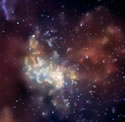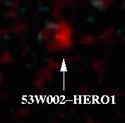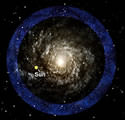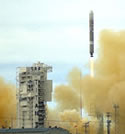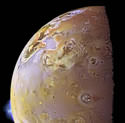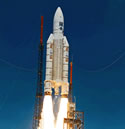
Image credit: Arianespace
According to a commission of inquiry, the failure of the new Ariane 5-ESCA rocket appears to have been caused by a leakage in the cooling system. Approximately 456 seconds into the vehicle’s flight, it veered off course and had to be destroyed. With it went two satellites worth 600 million euros. The results of this inquiry clear the way for the launch of the Rosetta comet mission in the next few weeks.
The Inquiry Board appointed to investigate the failure of Flight 157 submitted its report to Arianespace on January 6, 2003. The board was named last December 13 to establish the causes of the anomaly during the flight of an Ariane 5 ECA on the night of December 11-12, 2002.
As requested, the board established the most probable cause for the mission failure, examined possible consequences for the baseline Ariane 5 launcher version, and recommended actions to correct the problems that occurred during the Ariane 5 ECA flight
Arianespace has accepted all the recommendations of the board, and will prepare an action plan by January 20 to enable a return to service of the Ariane 5 ECA during the second half of 2003.
The Inquiry Board
Cause of the failure
A complete analysis of all measurements recorded during Flight 157 was carried out, along with a review of documentation concerning production, quality and technical records for the Ariane 5 ECA, as well as for all Ariane 5 flights to date. Also reviewed by the board was the work of production and development teams in Europe.
The board’s findings confirm that all preparatory and countdown operations for Flight 157 went normally, as did the flight sequence until the separation of the solid boosters.
The report of the Inquiry Board did identify the occurrence of a leak in the of the Vulcain 2 nozzle’s cooling circuit during this first flight phase, followed by a critical overheating of the nozzle – which led to a loss of its integrity.
This resulted in a major imbalance in the thrust of the Vulcain 2 engine due to the nozzle’s deterioration, leading to a loss of control over the launcher’s trajectory.
# In conclusion, the most probable cause of the failure of Flight 157 was the simultaneous occurrence of two aggravating factors: The degraded thermal condition of the nozzle due to fissures in the cooling tubes, and
# Non-exhaustive definition of the loads to which the Vulcain 2 engine is subjected during flight
The board also noted that it would be difficult to simulate these additional loads during ground tests.
Consequences for the Ariane 5 Baseline
The designs of nozzles on the Ariane 5 Baseline’s Vulcain 1 engine and the Vulcain 2 engine for Ariane 5 ECA differ in two main ways:
# The shape of the cooling tubes, which form the structure of the nozzle, and
# The technology of the nozzle’s stiffeners.
After reviewing operating data from the Vulcain 1 engine’s 12 successful flights, the Inquiry Board did not identify any weaknesses concerning the functioning and resistance of its nozzle. The Inquiry Board nevertheless requested an exhaustive examination of the behavior of the Vulcain 1 engine nozzle, including precise modeling to demonstrate the component’s correct behavior during the flight. These verifications currently are in progress.
Consequences for Ariane 5 ECA
The Inquiry Board requested that the following actions be taken:
# Modification of the Vulcain 2 nozzle, taking into account experience acquired with the Vulcain 1 engine nozzle,
# Assessment of possibilities for simulation during ground tests of loads observed during actual flight on the Vulcain 2 engine, and
# Enhancing of the quality of flight equipment.
Consequences for Rosetta launch
In view of the specific factors involved in this flight, Arianespace has decided to create a Review Board to make a decision on Tuesday, January 14 regarding the mission’s launch date.
Upcoming Arianespace launches
# February 11: Ariane 4
# Second half of February: an Ariane 5 Baseline launcher version
Original Source: Arianespace News Release

